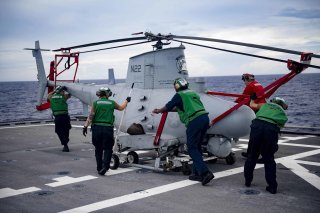How Unmanned Drones Can Support Marine Corps Amphibious Operations
The Marine Corps has been testing the MQ-8C Fire Scout drones alongside attack helicopters. The Fire Scout could play a critical role to enable amphibious operations.
Amphibious operations would require information about minefields, enemy fortifications, and force positions to ensure success. The speed with which that information can be relayed can make all the difference to victory or defeat.
That’s one reason why the U.S. Marine Corps is strengthening its networking and data transmission between attack helicopters and MQ-8C Fire Scout drones. Improving communication and delivering information to decision-makers faster will help the Marine Corps carry out amphibious operations in contested areas.
In a recent exercise at Naval Air Facility El Centro, California, the Marines linked UH-1Y Venom and AH-1Z Viper helicopters with sensor data coming from a Fire Scout drone.
“Marines and sailors operating in the ground control station assisted with the target detection and strike coordinate utilizing a MQ-8C Fire Scout,” a Marine Corps press release said.
The Marine Corps has focused on manned-unmanned teaming to improve its networking and information processing capabilities. The Fire Scout, one of the Navy’s unmanned helicopter systems, is a logical candidate for use in manned-unmanned teaming.
The Fire Scout has participated in a wide range of operations for several years, including operations that could assist amphibious operations. The Fire Scout’s Coastal Battlefield Reconnaissance and Analysis (COBRA) sensor system helps find and identify mines and other threats in littoral and coastal environments.
COBRA reached initial operational capacity in 2017 and has continued to serve aboard Fire Scout drones since then.
“Previously, such reconnaissance was only possible by putting Sailors or Marines on the beach in advance of a landing, exposing them to casualties and revealing an intended landing zone,” a 2017 Navy press release said.
Fire Scout drones with COBRA have since deployed on littoral combat ships equipped with mine countermeasure mission packages.
Kris Osborn is the Defense Editor for the National Interest. Osborn previously served at the Pentagon as a Highly Qualified Expert with the Office of the Assistant Secretary of the Army—Acquisition, Logistics & Technology. Osborn has also worked as an anchor and on-air military specialist at national TV networks. He has appeared as a guest military expert on Fox News, MSNBC, The Military Channel, and The History Channel. He also has a Masters Degree in Comparative Literature from Columbia University.
Image: U.S. Navy Flickr.

